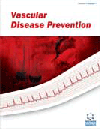- Home
- A-Z Publications
- Vascular Disease Prevention (Discontinued)
- Previous Issues
- Volume 5, Issue 4, 2008
Vascular Disease Prevention (Discontinued) - Volume 5, Issue 4, 2008
Volume 5, Issue 4, 2008
-
-
Edema, Inflammation and Fibrosis - Comparison Between Catecholamine- and Hypoxia-Induced Pulmonary Injuries
More LessAcute alveolar hypoxia often causes pulmonary edema which is associated with pulmonary inflammation and later on, with transition into fibrosis. Strong sympathetic activation and elevated plasma levels of catecholamines (CAs) induce similar changes in the lung. Adrenergic mechanisms are involved in circulatory changes, in formation and resolution of pulmonary edema, in the activation of proinflammatory cytokines as well Read More
-
-
-
The Trigeminocardiac Reflex as Oxygen Conserving Reflex in Humans: Its Ischemic Tolerance Potential
More LessAuthors: Bernhard Schaller and Klaus PrankThe trigemino-cardiac reflex (TCR) is defined as a sudden onset of parasympathetic dysrhythmia, sympathetic hypotension, apnea or gastric hypermotility during the stimulation of any of the sensory branches of the trigeminal nerve. The sensory nerve endings of the trigeminal nerve transmit neuronal signals via the Gasserian ganglion to the sensory nucleus of the trigeminal nerve, forming the afferent pathway of the Read More
-
-
-
Fenoldopam in Cardiovascular Surgery: A Review
More LessAuthors: Giovanni Landoni, Francesco A. Garozzo, Anna Mizzi and Alberto ZangrilloAcute kidney injury is a serious complication following cardiovascular surgery, resulting in significant inhospital and long-term morbidity and mortality. The mortality rate is distressingly high despite improvements in intensive care and dialytic technology, but survivors experience an acceptable quality of life. Fenoldopam mesylate is a dopamine A-1 receptor agonist that decreases systemic vascular resistance while in Read More
-
-
-
Elevated Levels of Soluble Fibrin in Patients with Thrombosis or a Pre- Thrombotic State
More LessBackground: Soluble fibrin (SF) is considered to be useful for the diagnosis of thrombosis, however, evidence for the diagnosis of pre-thrombosis by SF is still not well established. Objective: The present study was designed to evaluate the usefulness of new SF assay (New SF) in the diagnosis of thrombosis and a pre-thrombotic state. Patients/Methods: The plasma concentrations of New SF were measured in 748 inpatients suspe Read More
-
-
-
A Review of Surrogate Markers for Atherosclerosis: Flow Mediated Dilatation; Carotid Intima Media Thickness; Pulse Wave Velocity; Ankle Brachial Index
More LessAuthors: Kai-Hang Yiu, Kui-Kai Lau, Chu-Pak Lau and Hung-Fat TseAtherosclerotic disease is a major cause of morbidity and mortality. The early detection of preclinical atherosclerosis with non-invasive tools has become paramount in order to identify the vulnerable patient and provide aggressive prevention measures. A valid surrogate marker should not only be proven to correlate with underlying atherosclerosis but also needs to be accurate, reproducible and inexpensive. There are curr Read More
-
-
-
Circadian Variation of Cardiovascular Events and Morning Blood Pressure Surge
More LessMost cardiovascular functions exhibit circadian changes. On one hand, predictable-in-time differences in the physiological status of the cardiovascular system give rise to rhythmic variations in the susceptibility to morbid and mortal events. On the other, the pathological mechanisms of cardiovascular disease exhibit temporal changes in both their manifestation and severity, leading to predictable-in-time differences in Read More
-
-
-
Role of Ultrasound Vascular Imaging in the Acute Phase of Stroke
More LessAuthors: Giovanni Malferrari, Marialuisa Zedde and Norina MarcelloAcute ischemic stroke remains one of the main causes of death and disability in the world. The only approved therapy for stroke is the intravenous thrombolysis with recombinant tissue plasminogen activator within 3 h from symptom onset. The European, American and Canadian guidelines define unenhanced brain CT as the only imaging technique mandatory before thrombolysis. Its only goal is the exclusion of hemorrhage Read More
-
Most Read This Month
Article
content/journals/vdp
Journal
10
5
false
en


